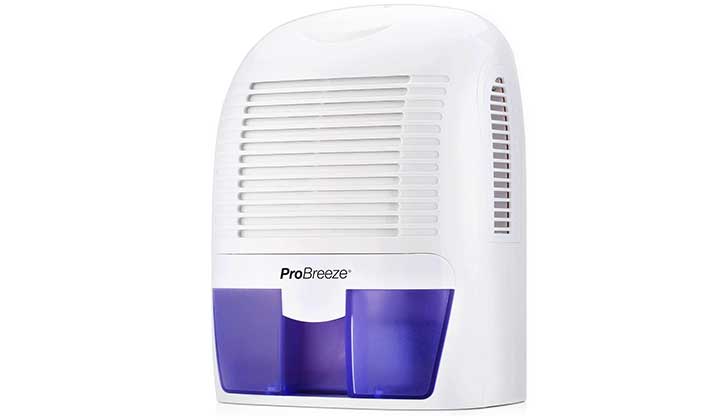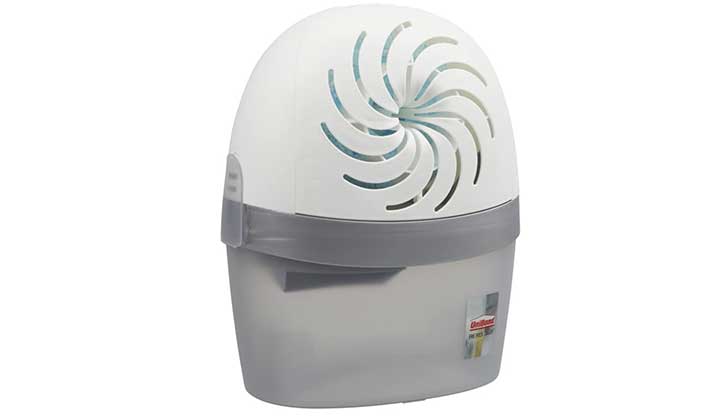Damp. It’s one word that can strike fear into any motorhome owner. Once it’s taken hold in your ‘van, it will be joined by mould and mildew. While making sure your ‘van is well-ventilated will be the best way to prevent damp, having the best motorhome dehumidifier can also help on a shorter-term basis.
After buying the best motorhome, it’s understandable you would want to do everything you can to keep it in tip-top condition – which is why getting the right dehumidifier can be an important decision. There are both electric and non-electric options available.
An electric motorhome dehumidifier gives you the benefit of being able to absorb much more water from the air than their non-electric counterparts. However, as with any electrical gadget, whether the best heater for a campervan or a dehumidifier, you’re going to need the means to power it, as well as considering the cost of running it. When the tank is full up, they should automatically switch off, but this means they will also need to be emptied.
Then there are the more budget-friendly non-electric dehumidifiers, which use crystals or tabs to soak up the moisture in the air. These will normally need changing every one to three months, depending on the exact one you opt for.
Here, we’re sharing our favourite motorhome dehumidifiers on the market, including both electric and non-electric options – there’s even a hanging option that would be ideal for smaller spaces such as your ‘van’s wardrobe.
Practical Motorhome is supported by its audience. When you purchase through links on our site, we may earn an affiliate commission. Learn more.
The best motorhome dehumidifiers:
Pro Breeze 1500ml Dehumidifier
Meaco Portable Dehumidifier DD8L
UniBond Aero 360 Moisture Absorber
Meaco Portable Dehumidifier DD8L Junior
Ansio Dehumidifier Pack
Pro Breeze 500ml Dehumidifier
Ansio Wardrobe Dehumidifier Hanging Pack
The best motorhome dehumidifier

Pro Breeze 1500ml Dehumidifier
- Tank capacity: 1500ml
- Weight: 1.85kg
- Dimensions: 220 x 160 x 300mm
Reason to buy:
- Runs quietly, automatic shut-off
Reason to avoid:
- Needs electricity
This motorhome dehumidifier from Pro Breeze is an electric option so you’ll need to make sure you have access to power if you’re thinking of buying it.
However, we think it is an effective dehumidifier to consider and we like how it’s capable of absorbing as much as 500ml of moisture each day. It comes with a 1500ml tank, and once it has filled up, you’ll know it’s time to empty it as the product will turn off. The LED light it comes with will then light up, letting you know that it needs emptying.
Thanks to its weight of 1.85kg, we like how it should be relatively easy to manoeuvre. We also like that it will run in the background, with its thermo-electric Peltier technology ensuring it operates quietly and shouldn’t distract you too much from what you’re doing if you’re using it while in your motorhome.

Meaco Portable Dehumidifier DD8L
- Tank capacity: 2 litres
- Weight: 6.4kg
- Dimensions: 351 x 188 x 500 (W x D x H in mm)
Reason to buy:
- Powerful, works effectively in colder temperatures
Reason to avoid:
- Expensive
This may be the most expensive product to feature in our guide, but we think this electric dehumidifier from Meaco comes loaded with features that will help you keep on top of any excess moisture in your motorhome. We like how it has a two-litre tank and is capable of absorbing up to 8 litres per day.
It has the useful safety feature of automatically turning off when the tank is full, giving you some peace of mind, and we’re also impressed by how the dehumidifier can give you cleaner air, as it comes with an anti-bacterial filter and ioniser, the only option in our guide to do so.
Another clever feature sees the fans run for an additional five minutes before turning off for 30 minutes, making sure the target air humility has been met. Then, after 30 minutes have elapsed, it will repeat the test, before turning off for another 30 minutes.
We also like that it’s well-suited to colder temperatures, as it’s a desiccant dehumidifier, and can operate at temperatures below 10C. There’s no avoiding the price, but if you’re looking for an effective way of keeping on top of moisture, as well as achieving cleaner air in the process, this could be the best motorhome dehumidifier for you.

UniBond Aero 360 Moisture Absorber
Reason to buy:
- Budget-friendly, non-electric, runs silently
Reason to avoid:
- You’ll need to replace the tabs
We’d say this non-electric motorhome dehumidifier is a good model to consider if you want a budget-friendly option for your ‘van that will run silently and doesn’t require electricity. Thanks to its compact and portable design, we reckon it could be well suited to owners of small motorhomes. It’s designed to offer 360-degree air circulation, and something we like is that it’s not only simple to set up but also to operate.
However, one thing we will highlight is that it requires tabs to operate, and with each one lasting for up to three months, they will need replacing. However, we like how they have an indicator on the side which will allow you to keep an eye on when it’s time to change.

Meaco Portable Dehumidifier DD8L Junior
- Tank capacity: 2 litres
- Weight: 6.4kg
- Dimensions: 351 x 188 x 500 (W x D x H in mm)
Reason to buy:
- Capable of absorbing up to eight litres a day, has a large 2L tank
Reason to avoid:
- Doesn’t come with the ioniser and anti-bacterial filter seen in the DD8L
The cheaper version of the DD8L from Meaco offers many of the features seen in its counterpart, including the ability to absorb as much as eight litres of moisture a day and an impressive two-litre water tank. We like the peace of mind that the electric dehumidifier provides too, as it will shut off automatically once the tank is full. Helpfully, it comes with a built-in timer, and it also runs quietly, so if you have a means of powering it while you’re in your motorhome, it shouldn’t prove too disruptive.
It has the same weight and dimensions as the DD8L – however, what we will point out is that this model doesn’t come with an anti-bacterial filter or ioniser, which will help to achieve cleaner air. If those are two features you’d like, the DD8L would be worth getting instead. However, if you’re not looking for that in your motorhome dehumidifier, the DD8L Junior is a cheaper alternative.

Ansio Dehumidifier Pack
Reason to buy:
- No electricity needed, easy to set up
Reason to avoid:
- Will need to be replaced
We like the versatility provided by these portable motorhome dehumidifiers, which comes in sets of five, 10, 20 or more, depending on your requirements. The lightweight dehumidifiers are easy to set up and have been formulated with hydrophilic crystals that should draw moisture from the air. They should then last for between four to six weeks.
We also think it’s handy that no electricity is required for these to operate – simply set them up and let them get to work, making them ideal if you’re not sure you will have the means of powering an electric dehumidifier.
The first drop should appear within one to three weeks, the manufacturer advises, but once operational, the product should be able to soak up to three times its own weight.
Check the latest price on Amazon now.

Pro Breeze 500ml Dehumidifier
- Tank capacity: 500ml
- Weight: 1.04kg
- Dimensions: 156 x 130 x 220 mm
Reason to buy:
- Lightweight, portable
Reason to avoid:
- More suitable for smaller ‘vans
A smaller version of the 1500ml Pro Breeze option that also features in our guide, this more compact dehumidifier can absorb as much as 250ml of moisture from the air each day. It comes with a 500ml capacity but we should point out this means it will need emptying most days to prevent the automatic shut off coming into effect.
We think its light weight could be another appealing feature for motorhome owners, as it only comes to 1.04kg. The process of emptying the tank is straightforward too – just remove the plug and then empty it using the water outlet. We also like how it comes with advanced Peltier technology – like its 1500ml counterpart, this means it operates quietly so shouldn’t disturb you when you’re using it. For those who have a campervan with less room to manoeuvre inside and have the means to power it, this could be well worth considering.

Ansio Wardrobe Dehumidifier Hanging Pack
Reason to buy:
- Ideal for smaller spaces
Reason to avoid:
- Will need replacing
This pack of hanging dehumidifiers provides some useful versatility to motorhomers. We like how they come in a variety of sizes, with the smallest pack of six letting you try them out if you so wish before stocking up on the bigger options of 12 or even 60. We like how they’re fairly reasonably priced and could then be hung in your ‘van’s wardrobes to help prevent any mould from taking over.
The first drop normally appears after around four to seven days, depending on the humidity of the space. The manufacturer advises they last for between four to six weeks, so we should point out you will need to replace them after they’ve run out. However, for a budget option to use in a smaller space, we think this could be a great choice.
How to choose the best motorhome dehumidifier
The biggest decision facing ‘van owners looking for a motorhome dehumidifier will be whether to opt for an electric or a non-electric option.
The advantages of a non-electric product is that they’re more budget-friendly than their electric counterparts and you don’t have to think about how you’re going to run it. However, you will need to get tabs or crystals, depending on what they use, to absorb the moisture from the air. On average, you’ll need to change these every one to three months. In some cases, such as the hanging wardrobe dehumidifier, you will need to replace them altogether around every four to six weeks.
In contrast, an electric option will be capable of absorbing more moisture and is a good choice if you have access to power them. However, while they will not need tabs or crystals, you’ll need to think about the running costs. They should, generally, come with an automatic shut-off feature if the tank is full, but it also means you will have to be able to access your ‘van to empty the tank too.
If you’ve enjoyed reading this article, why not get the latest news, reviews and features delivered direct to your door or inbox every month. Take advantage of our brilliant Practical Motorhome magazine SUBSCRIBERS’ OFFER and SIGN UP TO OUR NEWSLETTER for regular weekly updates on all things motorhome related.









